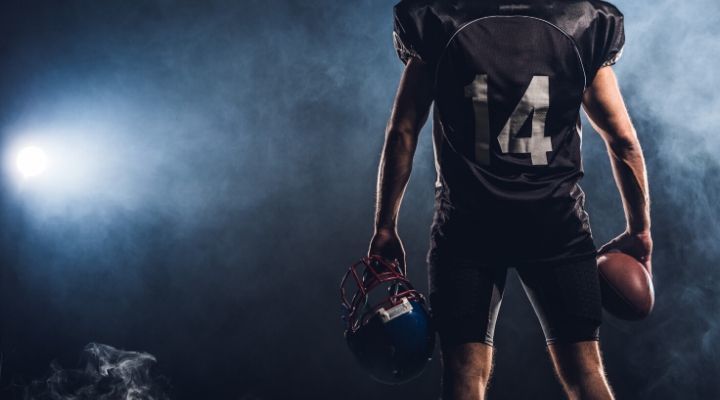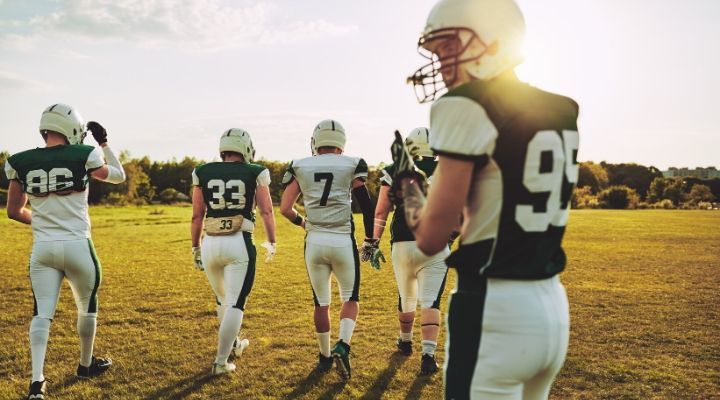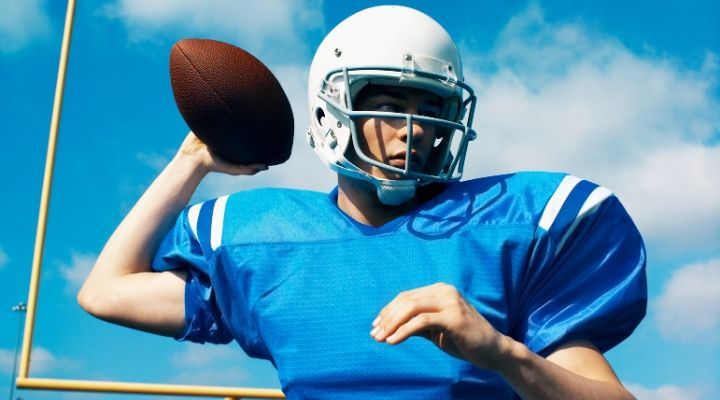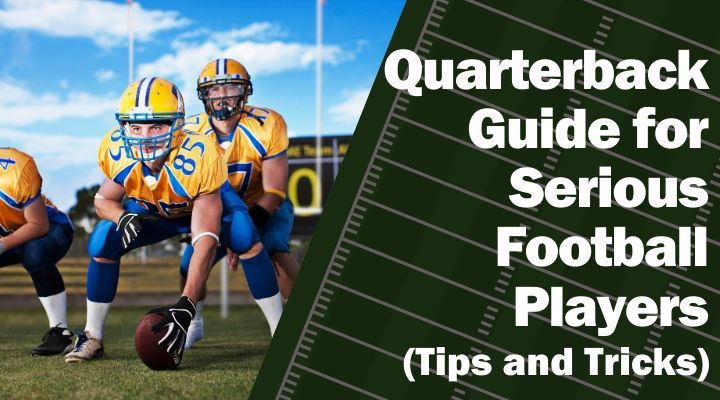Quarterback (or ‘QB’) is the position in football that often receives the most glory and the most praise.
In fact, if you ask people who they think the greatest football players of all time were, chances are that list a quarterback:
Tom Brady, Joe Montana, Peyton Manning, Johnny Unitas, Otto Graham, John Elway, Sammy Baugh, Brett Favre, Drew Brees, Roger Staubach, Aaron Rodgers – the list goes on.
Even some of the biggest names in today’s game like Patrick Mahomes, Josh Allen, and Lamar Jackson play quarterback.
QBs are the focal point of the offense, the ones who call the shots. And more often than not, they're the leaders of the team – both on and off the field.
However, all the praise and glory the position brings comes with a ton of pressure – to lead, to score, to win.
If you play QB and want to develop your game, here’s our full guide on how to dominate the game as one.

What is a Quarterback in Football?
Quarterbacks are the focal point of the offense – as everything on that side of the ball runs through them.
Before a play even starts, QBs lead the offense in a huddle to make sure everyone knows what the next play will be.
After lining up, QBs will then read the defense and make necessary adjustments on the fly – making sure everyone’s on the same page before calling for the snap.
QBs receive just about every snap throughout a game prior to them passing to receivers, handing it off to a running back, or running the ball themselves.
Whether it’s a handoff or a pitch, a long pass downfield or a quick hit, or even a possible run up the middle... QBs touch the football on just about every offensive play.
Quarterbacks have a more direct impact on the outcome of a game than any other individual player on either side of the ball.
While some people may look at a QB and see it as an easy job, quarterbacks need to be true students of the game.
They must master the playbook, read defenses, make audibles and adjust the offensive play, as well as understand the psychology of what makes players tick.
Quarterback Position on the Field
Quarterbacks receive the ball on just about every snap to start an offensive play.
To do this, QBs start by lining up in the backfield, directly behind the Center who’s in charge of snapping the ball.
Depending on the play, they’ll line up in one of two ways – (1) directly under center or (2) in shotgun formation.
QBs start in the backfield, behind the offensive line, usually joined by 1 or 2 running backs.
An exception to this is when the offense runs certain trick plays that sees the QB act as a decoy or receiver.
Here, the offense tries to catch the defense off guard as the center snaps the ball directly to another player (usually a receiver or running back).
What Does a Quarterback Do?
Quarterbacks play arguably the most important role for any football team, especially on the offensive side of the ball.
But aside from calling the plays, throwing the ball, and handing it off, what do they do?
Here’s a list of their roles & responsibilities:
1. Read Defenses
Before the ball is even snapped, a quarterback must scan the defense's alignment and see how it matches up with the offensive play that's been called.
If he feels the offensive play won't work well against the defensive play, he must decide on a new play and call the audible.
After the ball is snapped on passing plays, the quarterback will constantly scan the field, looking for the best opportunity to throw the ball.
He'll do this by recognizing whether the defense is in zone coverage or man-to-man, and what areas of the field would be his best chance for a successful completion to a receiver.
2. Direct Other Players
The quarterback has the responsibility of making small adjustments to plays that are called based on what he reads from the defense.
This is especially true at more advanced levels of football as coaches give the players more leeway to make decisions.
The quarterback can send a wide receiver in motion from one side of the field to the other if he sees something in the defense he thinks he can take advantage of.
He can tell the running back to stay in to block on passing plays where he thinks he'll need extra protection. Or, he can change the direction of a running play from the left to the right.
A quarterback will do all this in just a few seconds after calling the offensive play and then seeing how things look at the line of scrimmage.
3. Limit Mistakes
Even the greatest quarterbacks of all-time throw interceptions. It's an inevitability of playing the position.
Sometimes, the defense will just call the perfect play or a defender will make a great move to intercept the pass.
The quarterback's job is not to be perfect. It's to limit the number of mistakes he makes. Especially mental mistakes that are made due to a lack of focus or an obvious misread.
Mistakes aren't just interceptions, though.
A quarterback must protect the ball as best he can all the time, even when sustaining big hits from defenders.
He also must strive to complete the easy passes and not miss wide open targets.
4. Put the Team on His Back
Ultimately, it’s the quarterback's job to lead the offense to the end zone, or at least close enough that the kicker can attempt a field goal.
Sometimes, this will require the quarterback to put the team on his back and will them to victory.
A quarterback can do this by making the seemingly impossible throw, by escaping pressure to get free, by calling the perfect audible, and by talking other players up to motivate them to do well.
7 Quarterback Traits
There are different traits a QB needs to succeed, and we’ve touched on a bunch of them earlier.
These QB traits are what set the great ones apart:
1. Intelligence
Before talking about any physical skills, let's discuss the mental ones.
Great quarterbacks, first and foremost, are dedicated students of the game.
It's necessary for the quarterback to learn the roles and responsibilities of EVERY player on the field - for every play.
A quarterback needs to know what each player on his team will be doing on every play, as well as what possible things the defenders may do in response.
This is perhaps the most important trait of a great quarterback.
Plenty of people can throw a football, but not many people have the ability to watch, digest, and understand the game.
2. Composure
Quarterbacks are under constant pressure.
When they drop back to pass, there will be at least four big, hulking, fast defenders coming his way. Their aim is to hit him hard to the ground before he's able to throw the ball.
A great quarterback will be able to recognize the pressure coming his way without allowing it to disrupt him.
He must be able to make adjustments on the fly. Stepping up in the pocket or scrambling outside to avoid pressure - as he looks to complete a successful pass to one of his receivers.
Whether it's the first play of the game or fourth-and-two with the game on the line, a quarterback must maintain his composure and stay calm.
3. Leadership
A quarterback must be a leader both on and off the field.
But what does this mean, exactly?
A quarterback must get to know each player on the team very well, especially those on offense, and understand what motivates them to succeed.
He must be able to rally the troops and get them to accomplish a common goal.
And when needed, a quarterback must find ways to calm the team down if they're overreacting to something that happened in the game.
To be a great leader, a quarterback must be respected by all players. He earns this respect by being the hardest worker in practice, in the film room, and on the field. All while being approachable in the locker room and off the field.
4. Competitiveness
Quarterbacks must want to win at all times and do anything in their power to make that happen.
This competitiveness is what will fuel a quarterback to spend as many hours in the weight room as he does practicing throwing technique and studying the playbook.
Competitiveness is what compels them to spend hours and hours going through quarterback drills in their own time.
5. Vision
Now starts the physical traits section of the program.
Quarterbacks must constantly scan the field to see where defenders are coming from, what receivers are open, and if there's trouble brewing that’ll force him to improvise.
All of this takes exceptional vision.
It's impossible for a quarterback to do all of that while taking a lot of time and turning his head fully from one side of the field to the next.
As such, he must have great peripheral vision and the ability to understand what he's seeing and what he's not seeing.
6. Throwing Precision
Throwing the football with power takes a lot of arm strength.
Much like a pitcher in baseball, a QB must have a strong lower body and core as well as a strong arm to make those throws.
In fact, a lot of the power he'll get behind his passes will come from his legs and the torque he's able to create by rotating his hips and pushing off his back foot.
While having a strong arm is a good start, what makes a really great quarterback is a player who has excellent precision with his throws as well.
This is the biggest challenge for players learning to be quarterbacks.
They may be able to throw the ball hard and far, but putting the ball exactly where they want it when they want it is difficult.
There are also times when passing isn’t all about throwing as hard as you can.
Some passes take touch, such as swing passes to running backs or floaters over the defensive line.
A quarterback must be able to do this as well and recognize when he needs to throw hard and when he needs to back off a bit.
7. Mobility
A lot of great quarterbacks will never be mistaken for world-class sprinters.
Just take a look at some of the great QBs listed above. Speed was never a big part of Brady, Manning, and Favre's games.
However, what each one of them had -- and what all great quarterbacks have -- is the ability to move around in the pocket to find the perfect positioning on the field.
This takes great footwork and the ability to shuffle both side-to-side and front-to-back.
As the pass rush is developing, a quarterback may need to move out of the around pocket or out of the pocket to get to a clear throwing lane.
While he doesn't have to be fast to do this, he does have to be mobile.

Best Quarterbacks of All Time
With a rich history to the position, it’s definitely a challenge to come up with a Top 10 ranking of the Best Quarterbacks of All Time – but here we are.
Here’s my take on the Top 10 Best QBs of All Time:
1. Tom Brady
2. Joe Montana
3. Peyton Manning
4. Johnny Unitas
5. John Elway
6. Drew Brees
7. Dan Marino
8. Aaron Rodgers
9. Roger Staubach
10. Otto Graham
3 Quarterback Tips
If you’re looking to take your QB game to new heights, here are a few tips that can help:
1. Hit the Gym Hard
Quarterbacks need to be strong.
They don't just need a strong arm, though.
They need strong legs, a strong back, and a strong core.
They also need to have endurance.
This all requires a player to spend a lot of time in the gym, both in weight training and in running.
2. Hit the Books Hard
The only way for a quarterback to know the responsibilities of every offensive position is to study the playbook deeply.
The unique thing about playing quarterback is they really only do two things on any given play: (1) Hand the ball off, or (2) attempt to throw a pass.
He doesn't have to learn a blocking scheme, take a hand-off or a pitch, or know whether he's running a passing route, serving as a decoy, or blocking a defender.
This might make you think that it's easy for a quarterback to learn plays, but in reality, this makes it harder.
It means that a quarterback must actually learn what every other position's responsibilities are for every play.
And the only way to do that is to study and ask questions.
3. Watch the Game
The best way to learn how to play quarterback is to experience it for yourself in game situations.
The best way to prepare for that off the field is to simply watch the game.
These are some of the things you need to look out for:
1. What great QBs do in different situations.
2. How they react when a defender is bearing down on them.
3. What they do after they hand the ball off.
4. How they call a play in the huddle.
5. How they interact with coaches and players on the sideline when the defense is on the field.
Basically, just watch, learn, and enjoy.

Conclusion
Quarterback is the most glamorous position in football, but it's also one of the most demanding -- both physically and mentally.
While a quarterback really only has two basic on-field duties -- to throw or hand off -- there's a lot more that goes into those duties.
Truly mastering the position of quarterback takes years to do, both on the field and off it.
If you really want to be a great quarterback, hit the books hard, hit the gym hard, and be a student of the game.




